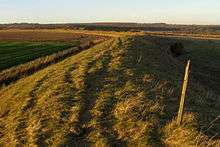Bokerley Dyke
Bokerley Dyke (or Bokerley Ditch) is a linear earthwork 5.75 kilometres (3.6 mi) long in Hampshire, between Woodyates and Martin. It is a Scheduled Monument.[1] It is also spelt Bokerly Dyke.[2]

Bokerley Dyke was excavated by Augustus Pitt Rivers between 1888 and 1891[2] and by Philip Rahtz[3] in advance of road widening in 1958. Bokerley Dyke may have originated in the Bronze Age or Early Iron Age and formed a political and cultural boundary.[4] It was cut through by a Roman Road (Ackling Dyke running between Old Sarum and Badbury Rings) in the 1st century.[4]
In the 4th century it was remodelled and brought back into use, and excavations show that the Roman road was blocked.[4][5] A coin of Valens dates this activity to shortly after 364 AD.[4] It may have been built in 367-8 AD when Roman sources report that Britain was attacked by Picts, Scots and Saxons in a supposed Great Conspiracy.[5] The Roman road was later reopened, but the dyke may have continued in use after the cessation of the Roman rule and still forms part of a boundary between the counties of Dorset and Hampshire.[4]
Bokerley Dyke runs through Martin and Tidpit Downs, which is a Site of Special Scientific Interest, and it is continuous with Grim's Ditch.
References
- "Bokerley Dyke, and a section of Grim's Ditch, a section of a medieval boundary bank, and two bowl barrows on and north west of Martin Down". Historic England. Retrieved 15 May 2020.
- Pitt-Rivers, Augustus Henry Lane-Fox, 1827-1900. (1887–1905). Excavations in Cranborne Chase, near Rushmore, on the borders of Dorset and Wilts. [Harrison and Sons, Printers] Printed privately. OCLC 863389459.CS1 maint: multiple names: authors list (link) CS1 maint: date format (link)
- Rahtz, Philip A. (January 1961). "An Excavation on Bokerly Dyke, 1958". Archaeological Journal. 118 (1): 65–99. doi:10.1080/00665983.1961.10854188. ISSN 0066-5983.
- Bokerley Dyke Archived September 30, 2012, at the Wayback Machine, Pastscape
- Bill Putnam, (2000), Discover Dorset: The Romans, page 71. The Dovecote Press
| Wikimedia Commons has media related to Bokerley Dyke. |